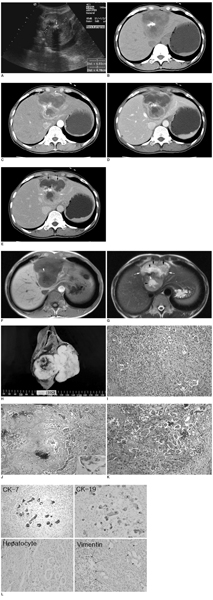Korean J Radiol.
2007 Aug;8(4):343-347. 10.3348/kjr.2007.8.4.343.
Carcinosarcoma of the Liver: A Case Report
- Affiliations
-
- 1Department of Radiology, Dongsan Medical Center, Keimyung University School of Medicine, Daegu, Korea. kjh2603@dsmc.or.kr
- 2Department of Pathology, Dongsan Medical Center, Keimyung University School of Medicine, Daegu, Korea.
- 3Department of Surgery, Dongsan Medical Center, Keimyung University School of Medicine, Daegu, Korea.
- KMID: 1110732
- DOI: http://doi.org/10.3348/kjr.2007.8.4.343
Abstract
- Primary hepatic carcinosarcoma is a rare tumor comprised of a mixture of carcinomatous and sarcomatous elements. Less than 20 adequately documented cases have been reported, however the imaging features of two cases were briefly described. We present here a case of carcinosarcoma of the liver in a 46-year-old woman, which was confirmed based on pathology. Imaging showed a large mass with large necrotic portions, small cystic portions, calcifications and bone formations.
Keyword
MeSH Terms
Figure
Reference
-
1. Freeman AJ, Bullpitt P, Keogh GW. Primary hepatic carcinosarcoma. ANZ J Surg. 2004. 74:1021–1023.2. Sumiyoshi S, Kikuyama M, Matsubayashi Y, Kageyama F, Ide Y, Kobayashi Y, et al. Carcinosarcoma of the liver with mesenchymal differentiation. World J Gastroenterol. 2007. 13:809–812.3. Rummeny E, Weissleder R, Stark DD, Saini S, Compton CC, Bennett W, et al. Primary liver tumors: diagnosis by MR imaging. AJR Am J Roentgenol. 1989. 152:63–72.4. Nomura K, Aizawa S, Ushigome S. Carcinosarcoma of the liver. Arch Pathol Lab Med. 2000. 124:888–890.5. Wang XW, Liang P, Li HY. Primary hepatic carcinosarcoma: a case report. Chin Med J. 2004. 117:1586–1587.6. Leger-Ravet MB, Borgonovo G, Amato A, Lemaigre G, Franco D. Carcinosarcoma of the liver with mesenchymal differentiation: a case report. Hepatogastroenterology. 1996. 43:255–259.7. Fayyazi A, Nolte W, Oestmann JW, Sattler B, Ramadori G, Radzun HJ. Carcinosarcoma of the liver. Histopathology. 1998. 32:385–387.8. Garcez-Silva MH, Gonzalez AM, Moura RA, Linhares MM, Lanzoni VP, Trivino T. Carcinosarcoma of the liver: A case report. Transplant Proc. 2006. 38:1918–1919.9. Weitz J, Klimstra DS, Cymes K, Jarnagin WR, D'Angelica M, La Quaglia MP, et al. Management of primary liver sarcomas. Cancer. 2007. 109:1391–1396.10. Stoupis C, Taylor HM, Paley MR, Buetow PC, Marre S, Baer HU, et al. The Rocky liver: radiologic-pathologic correlation of calcified hepatic masses. RadioGraphics. 1998. 18:675–685.


